Bikepacking Gear List: Everything you need for Multi-Day Adventures
Find all the bikepacking camping gear you need to head out on overnight adventures with this complete bikepacking gear list.
Not sure what to pack for your multi-day bikepacking adventure? You’ve come to the right place! Whether it’s your first time bikepacking or you’re looking to spruce up your gear closet, this bikepacking gear list covers all the basic essentials – plus a few comforts – you need to stay dry, comfortable, and safe while on your adventure.
My bikepacking gear preferences are always changing, but I’ve included everything I typically take with me on a multi-day bikepacking trip.
I hope this gear list helps you simplify your planning and if you’re new to bikepacking, give you some ideas on what gear to invest in that will last for many years.
I’ve also included a printable checklist so you can be sure to not miss a single item!
Bikepacking Gear Checklist at a Glance
Download a printable version here
and subscribe to my newsletter while you’re at it!
Camping & cooking
“luxuries”
Bikepacking clothes
Hygiene & personal care
Biking gear
tools & spares
Food & Nutrition
Electronics
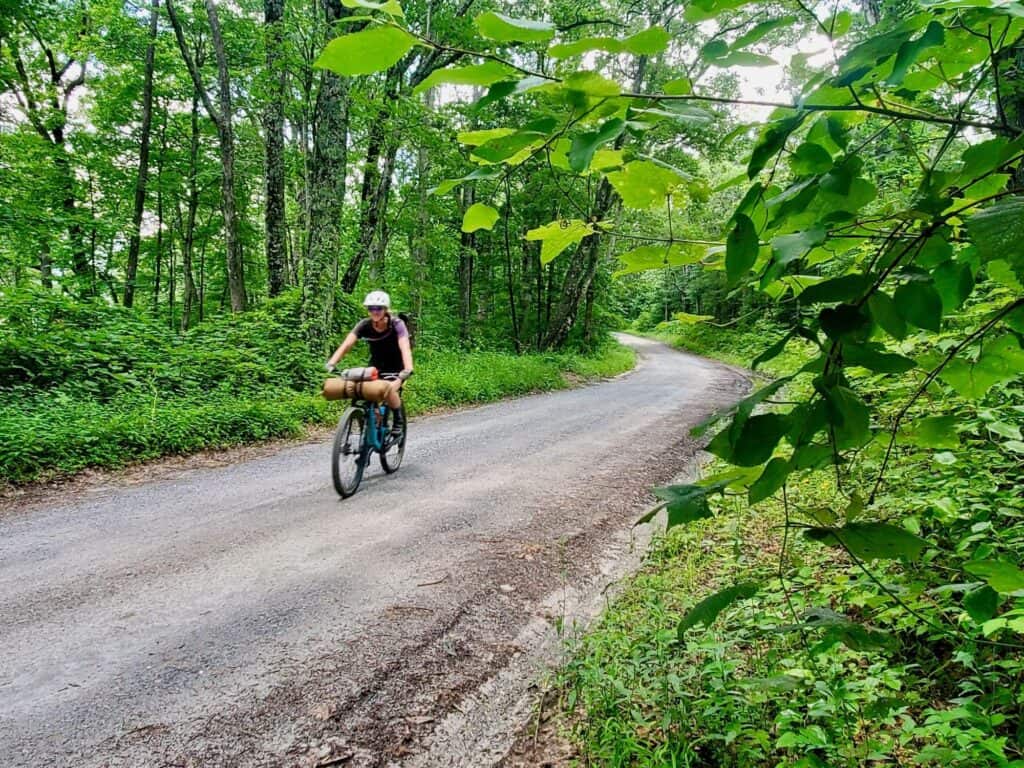
Need Help Planning Your Trip?
New to bikepacking? I’d love to help you plan your first (or next) overnight trip! Click the link below to set up a Q & A session.
Bikepacking camping + Cooking Essentials
Having the right camping gear can make or break a bikepacking trip. You want gear that is lightweight, yet durable and won’t fail you mid-way through a trip.
Here are my favorite bikepacking camping and cooking gear essentials.
Tent + footprint
Choose a lightweight tent for your bikepacking adventures – ideally something under 3-4 lbs.
I have the Big Agnes Copper Spur UL 2 tent, which is specific for bikepacking. It has short poles for easy storage, a harness bag that can be directly mounted to your handlebars, and a Fast Fly option for fair-weather trips.
Be sure to grab the footprint, too. You’ll want it for thorny camp spots or cold/wet days. The footprint is also needed for the Fast Fly setup.
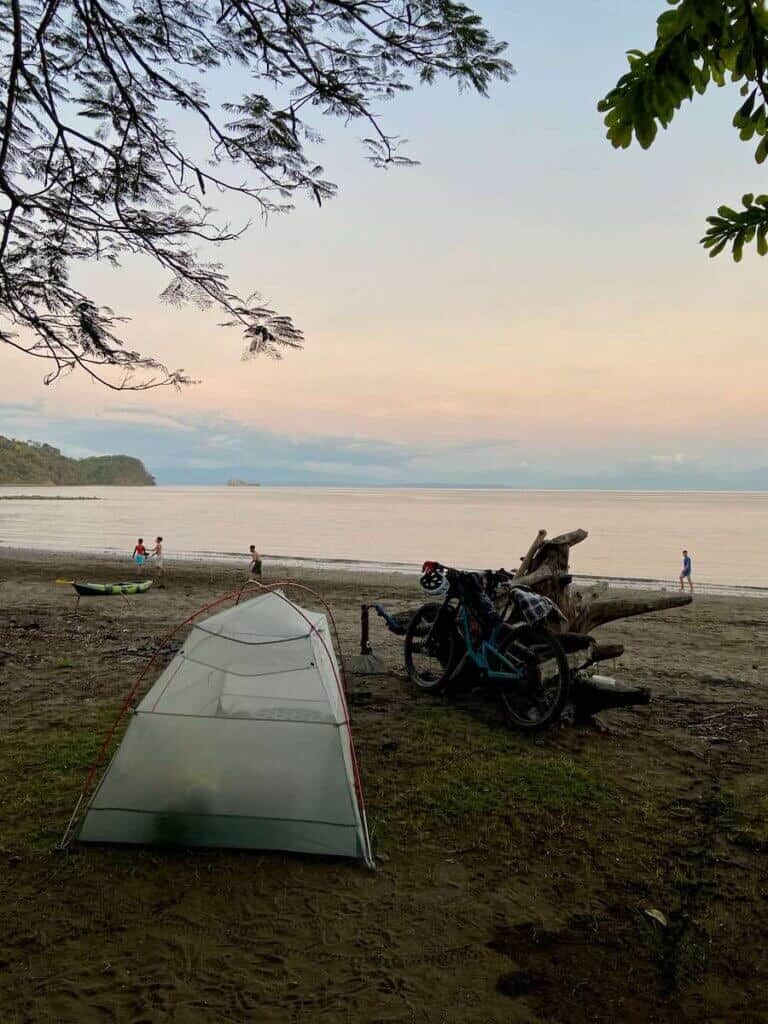
Sleeping bag
Choose a lightweight sleeping bag that can pack down small. A 30-degree bag will typically suffice for most adventures and you can always add a liner for colder trips.
I have the NEMO Disco 30 Sleeping Bag and it’s like sleeping on a cloud! I’m also a side-sleeper and the spoon-shape design allows for extra room. (Shop men’s version here).
Sleeping pad
I typically don’t sleep very well when camping, so I make sure to give myself the best chance at getting a good night’s sleep. That means a cushy sleeping pad.
I have the Sea To Summit Ether Light XT Sleeping Pad which is 4.5 inches thick and super comfortable, especially if you’re a side sleeper.
It also has a nifty PillowLock (made with magnets, I think?) so you don’t have to constantly keep your Aeros Pillow from sliding off.
The only drawback to this sleeping pad is that it doesn’t pack down super small, but it’s easy to attach to the exterior of a bikepacking bag. This one is a women’s, but it also comes in a men’s version as well.
Headlamp
A headlamp is a necessity for every overnight trip. There are a lot of great headlamps out there, but I like the BioLite HeadLamp 325 because it’s lightweight and rechargeable.
Giving off 325 lumens, this headlamp is bright enough to light up camp or, if you’re unlucky, fix a flat right as dusk is falling.
Camp stove + fuel
After using the MSR PocketRocket Stove for a few bikepacking trips, I decided to switch to the JetBoil Stash Cooking System because it’s much lighter weight and boils water a lot faster.
It’s great if you just need to boil water for dehydrated meals and coffee (which is typically what I eat on my bikepacking trips).
Fuel is not included, but you can buy it separately.
Tip: Don’t forget your matches and a lighter! Some stoves have an igniter but don’t solely rely on it. Bring both waterproof matches and a lighter.
Eating utensil
The Sea To Summit Long Spork is perfect for scraping the bottom of your dehydrated meal pouch.
Most forks or spoons are too short, but this one keeps your fingers from getting bits of food on them.
Mug or cup
Coffee is a non-negotiable for me, so it always makes it onto my bikepacking gear list.
The Snow Peak Titanium mug is ultra-lightweight at only 2.4 oz
Sharp knife
A knife is a bikpacking gear necessity. Use it to prepare food or meals, cut kindling, makeshift gear, or any other number of uses.
The Gerber Mini Paraframe Serrated Knife is small, lightweight, and reliable.
Water filter
Make sure you always have access to clean water with an effective and efficient water filter. The LifeStraw 3L Peak Gravity Filter filters 3 liters of water per minute and is super easy to use and most importantly, reliable.
TIP: If traveling abroad, bring AquaMira Drops to kill viruses.
Bear bag (if needed)
Depending on where you’ll be bikepacking, you may or may not need to be concerned about bears.
For bikepacking, a bear bag that you hang in a tree is a bit easier to carry on a bike than a bulky plastic bear canister.
The 10L Ursack AllMitey Bear and Critter Sack is a great option that deters both bears and smaller critters like rodents, which can honestly be just as destructive as bears.
Bikepacking “Luxuries”
These aren’t bikepacking essentials per se, but if you have the room for them and/or you don’t mind carrying a bit extra, they’re really nice to have.
Camp seat
My friend brought her Therm-a-Rest Z Seat with her on our Cross Washington bikepacking trip and I was super jealous (she let me use it a few times).
Weighing only 2 oz, it’s worth the extra space so that you don’t always have to sit on the ground, which can get old real quick especially if it’s damp or thorny!
Camp games
Depending on how much riding you do, you may have a lot of downtime at camp. My friend brings her lightweight cribbage board and cards when we bikepack together.
Other entertainment could include an e-reader, card games, dice, etc…
Bikepacking Clothes
How much clothing and the type of clothing you bring with you are going to vary depending on the length of your trip and the climate/terrain you will be bikepacking in.
Below is a general list of clothing to add to your bikepacking gear list:
Lightweight insulated jacket
An insulated jacket – or puffy – is a bikepacking gear essential. Even if you’re pedaling through the desert, nights can get cold or you might need an extra layer post-rainstorm as you cozy up in your tent.
My favorite insulated jacket is the Patagonia Nano Puff Hoody. It’s super lightweight, packs down small, and is surprisingly warm for its weight.
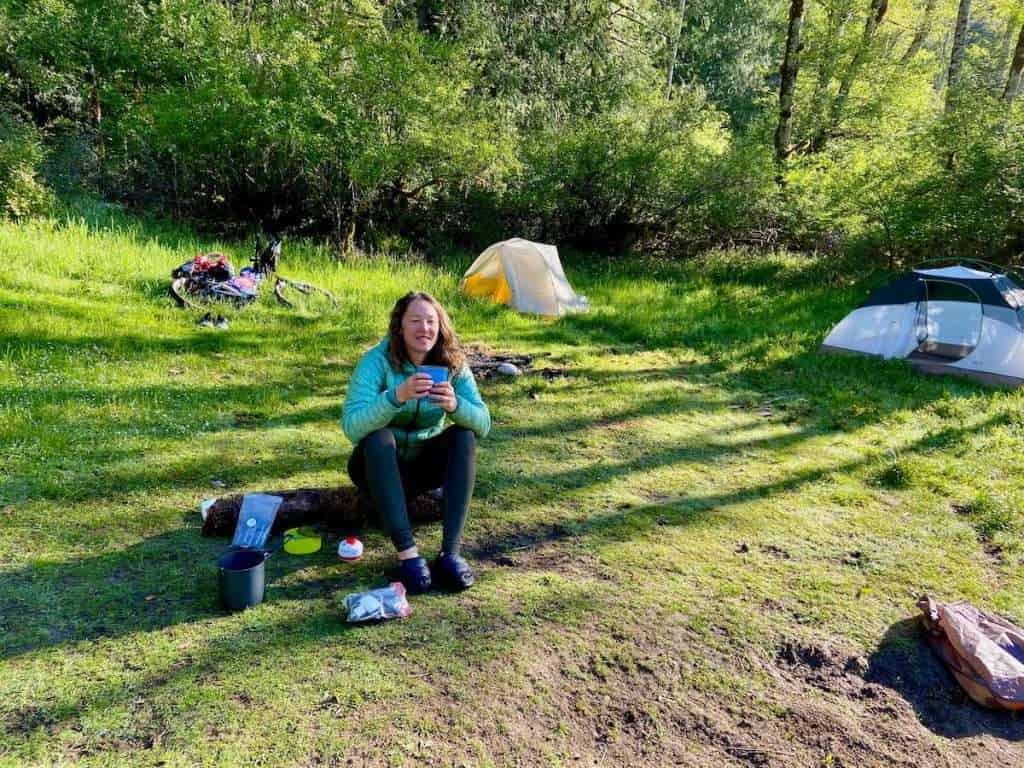
Wind jacket
If it’s not going to be cold, you can get away with a light wind layer like the Patagonia Houdini, which blocks cold gusts and repels light rain.
This is also a great layer to have if it IS going to be super cold and you need an extra layer to keep you warm.
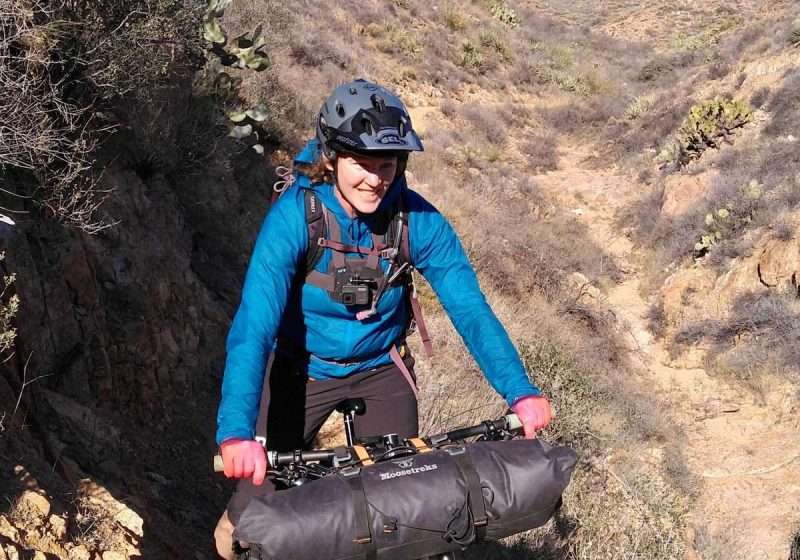
Chamois &/or shorts (2)
Whether you ride in baggie shorts or a chamois is your personal preference. I typically pack one of each.
My favorite chamois are the Terry Bella Prima liners. I haven’t really found a baggy short that I love for bikepacking yet.
Riding jerseys (2)
Any quick-dry shirt will work great for bikepacking. Choose synthetic materials or merino wool and stay away from cotton, which doesn’t dry quickly and can leave you feeling chilled.
I also like to pack a short-sleeve and a 3/4 or long-sleeve so I have options. I love Kaden Apparel’s jerseys for bikepacking because they’re soft, durable, a dry quickly.
Tip: If you’re heading somewhere hot and sunny, pack a loose long-sleeve button-up shirt. This will help keep your skin covered while still being versatile, and you can wet it down to help you stay cool.
Sports bra
Choose a good, supportive sports bra for bikepacking. My go-to is the Patagonia Wild Trails.
It’s not only supportive, but it’s also comfortable – a combo that’s hard to find when it comes to bras! I also LOVE that it doesn’t have removable cups.
Socks (2-3 pairs)
Darn Tough’s are my go-to socks because they are durable but when they do wear out, Darn Tough has a lifetime warranty. That’s right, when your socks get worn out simply send them in (clean) and get a new pair for no cost!
For bikepacking, the Mid-Weight Micro Crew socks are great. They’re made from moisture-wicking merino wool that dries fast and resists odor.
Buff (2-3 pairs)
A CoolNet UV+ Buff is a great versatile piece of bikepacking gear. It can be used for a number of different purposes including:
- Sun protection
- Keeping your head or neck cool (saturate it with water for extra cooling power)
- To ward off bugs and insects (spritz it with bug spray)
- Keep your face warm on chilly mornings
- Protect your lungs from city/traffic air pollution.

Set of camp/sleep clothes
I always pack a set of just camp/sleep clothes so I don’t have to sleep in dirty, sweaty clothes. For me, this typically includes:
- 1 pair of leggings or lightweight shorts
- 1 t-shirt
- 1 long-sleeve
- 1 pair of clean socks
- 1 warm hat
- 1 pair of sandals and/or booties

Rain gear
I don’t typically pack rain gear unless I know the forecast predicts heavy, cold rain (and if that’s the case, I may rethink my trip :).
But if you’re set on going despite the wet weather, pack some lightweight – but good – rain gear like the Shower’s Pass Ecolyte Rain Jacket and the Timberline Pants.
Biking gear
Helmet
I used my Troy Lee Designs A3 helmet on my 460-mile bikepacking trip through Costa Rica and loved how lightweight airy it felt. It has a whopping 16 vents for optimal airflow and it’s also MIPS certified, meaning your head is well protected should you find yourself facedown in the dirt.
I like the white color for bikepacking because it doesn’t absorb the sun’s heat as much as a dark helmet would.
Lastly, the visor isn’t so long that it will catch gusts of wind, but just long enough to shield your eyes from the sun.
Sunglasses
I’ve used my armless Ombraz sunglasses on several bikepacking trips now and I have to say, they’re awesome.
Instead of rigid sidearms that can easily break, they’re designed with a cord that pulls snugly against your head.
I was skeptical at first, but now I’m a convert! You can read my full review here.
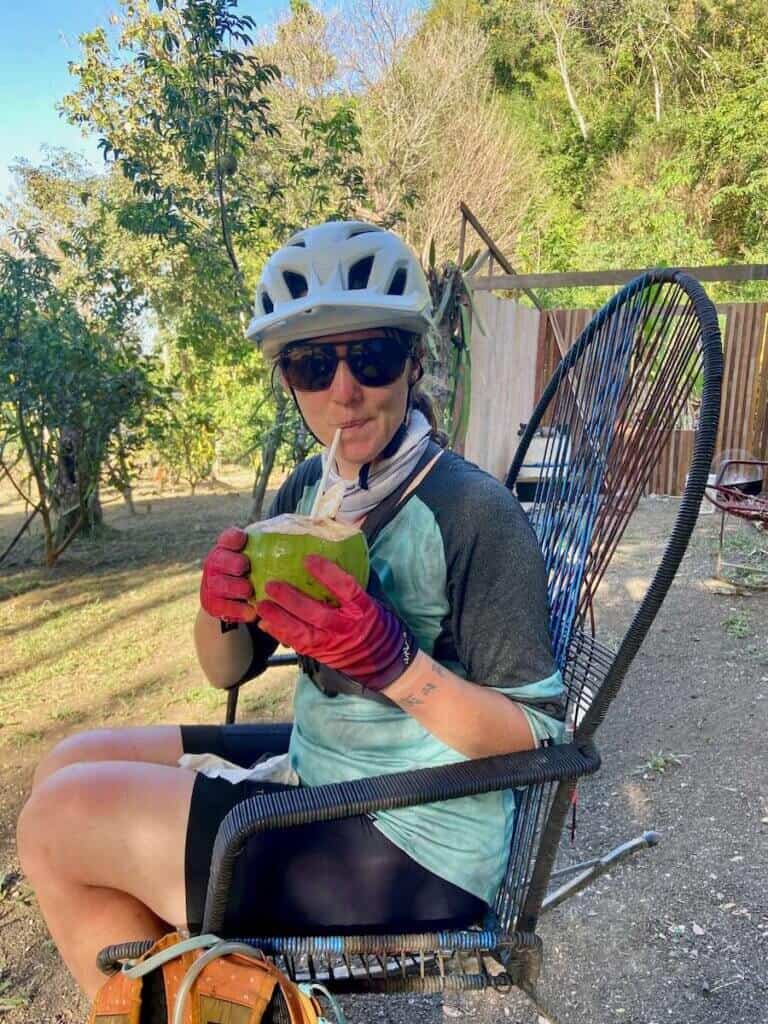
Shoes or sandals
Your shoe choice will – and should – change depending on what type of trip you’re doing.
I tend to prefer flats over clips because they’re easier to walk in and do non-biking things in. The Ride Concepts Flume shoes have great grip and breathable mesh uppers.
If I’m bikepacking someplace warm, I’ll even opt for open-toed sandals like the Teva Hurricane Sandal, which is what I wore in Costa Rica.
Gloves
I like to wear gloves whenever I’m biking because I sweat a lot and they help keep my hands from slipping on the handlebars.
They’re not a bikepacking essential, but I recommend packing a pair just in case you need them on hot, sweaty days (or cold days!).
Bikepacking bags / racks / harnesses / cages
It will take you some time to dial in your bikepacking bag set-up. My current preferred set-up are Rogue Panda bags. I have their handlebar roll, seat post bag, and frame bag. I love their durability and fun patterns and the fact that they’re hand-sewn in Flagstaff, Arizona.
You’ll also want to consider how else you want to carry gear whether that’s with a rack (see below), in cages, or even a backpack.
Read More
Bikepacking Setups & Bags
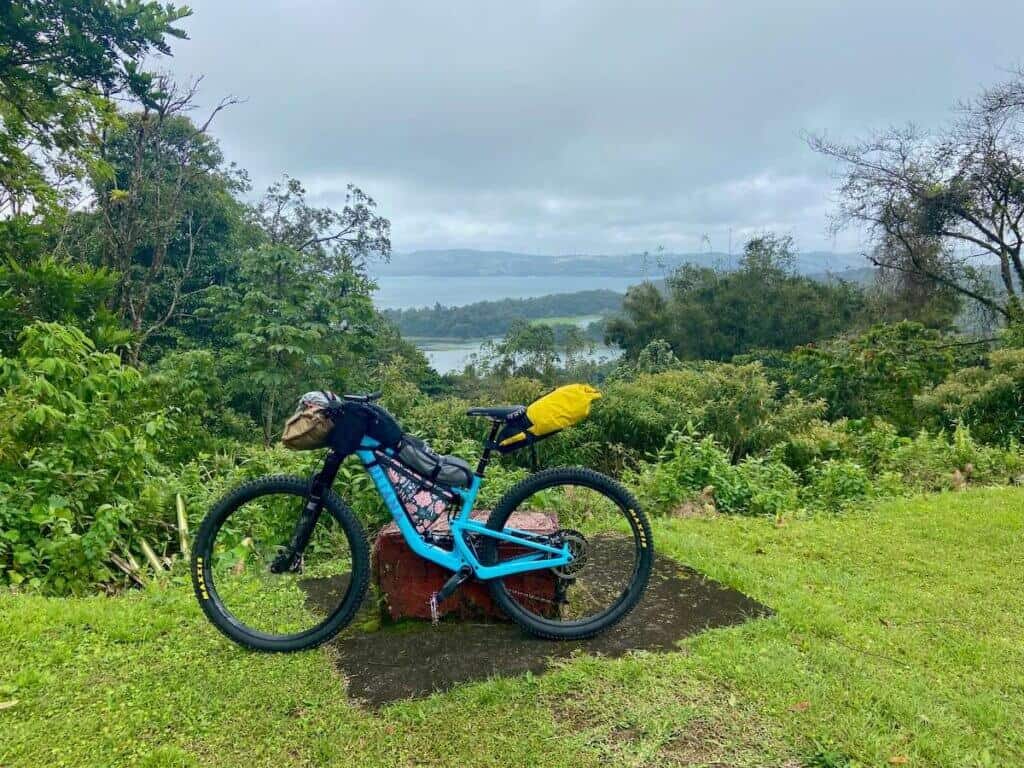
Should you use a rack?
Adding a rear (and/or front) rack and panniers to your bikepacking bike can allow you to carry a lot more gear, but they also add weight and can make your bike harder to maneuver and pedal.
If you’re doing mostly singletrack riding, I recommend trying to avoid using a rear rack.
If you’ll be on mostly dirt roads and the riding will be pretty straightforward, a rear rack with panniers should be fine. Just be careful to pack only what you need, not what will fit!
Old Man Racks makes lightweight racks that can be used with bikes that don’t have braze-ons (i.e. attachment points).

Voile straps (2-3)
Voile straps are very helpful for attaching wayward gear or adjusting your set-up mid-trip.
I typically pack 2-3 extra voile straps.
Bike lock
I like to have a bike lock with me for trips inside the grocery store, eating at a restaurant, or at busy campsites.
This Kryptonite Lock is pretty lightweight at 10.4 ounces and doesn’t require a key that can easily get lost.
Hydration pack / water bottles
I like to wear a hydration pack when I’m bikepacking because it gives me quick, easy access to water. My go-to pack is the Osprey Raven (or Raptor for the guys), but I know backpacks aren’t everyone’s preferred hydration system, especially for long days in the saddle.
If you don’t want to wear a backpack, you can opt for water bottles in fork cages or a fanny pack. But know that backpacks can also free up space on your bike frame for other gear.
Also, if you know you’ll need to carry extra water for stretches without a water source, pack a few empty hydration reservoirs.
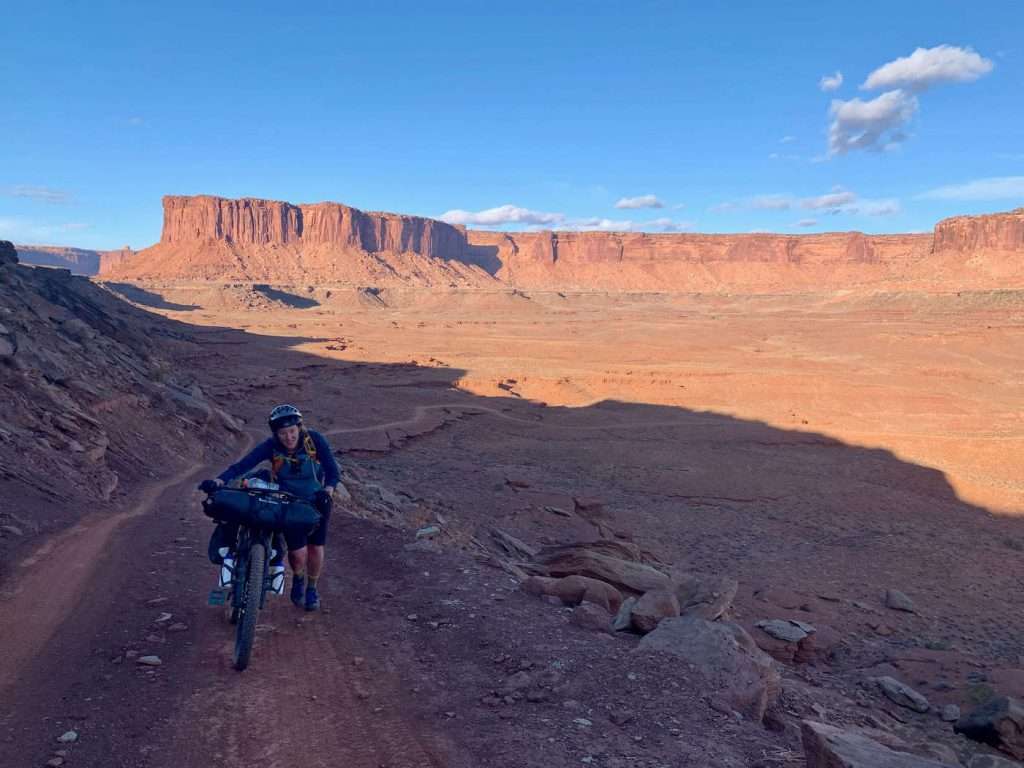
Bike tools + spares
Don’t skimp on your bike repair and tool kit! The last thing you want is to get a flat or break a chain in a remote area and have to walk who-knows-how-many miles to help.
Here’s what I recommend packing in your bike repair and tool kit:
Food & Nutrition
If you’re new to bikepacking – or you’re looking for some meal ideas – head over to my post on bikepacking food.
Below is a general list of what food and nutritional aids to pack:
Dehydrated meals
Dehydrated meals are by far the easiest way to cook and eat on bikepacking trips if you aren’t relying on restaurants and grocery stores.
Go for the bigger portion bags – you’ll need the calories!
Electrolytes
These little SaltStick FastChews electrolyte tablets make a huge difference for me when I’m bikepacking. I sweat a lot, so I lose a ton of sodium and other salts, which makes me fatigued and crampy.
But if I take these every 20-60 minutes it’s like I’m a new person. Be aware that they do contain sodium and they’re not for casual exercise.
Hygiene & Personal Care
While you should aim to pack as few toiletries and personal items as you can, bikepacking (as opposed to backpacking) does allow you the space to bring a few ‘extras’.
Electronics for bikepacking
It’s a good idea to minimize the electronics you take on your bikepacking trip, but there are a few that you won’t want to leave at home:
GPS computer + cord
I have the Garmin 830 Bike Computer which has helped me navigate a number of bikepacking routes. It’s pretty easy to use, although I recommend taking it on some shorter, easier rides so you can get a hang of how it operates.
You can read my full Garmin Edge 830 review here.
Power bank
I’d love to recommend a solar charger power bank, but honestly, I haven’t found one that works really well. Small solar chargers take eons to charge, so you’re better off packing a portable power bank and plugging it in whenever you get a chance.
The BioLite Charge 40 PD weighs only 0.6 lbs and can charge a smartphone up to 2.5 times.
GPS communication device
Accidents and scary things can happen, so it’s a good idea to bring a communication device. You won’t need it unless you do, so it’s better to be safe than sorry.
One of the best communication devices out there is the Garmin inReach Mini. It allows for two-way message communication, tracking, and SOS capabilities, and weighing in at only 3.5 oz you’ll hardly notice the weight.
You do need to sign up for a Garmin subscription in order to use the device, which you can learn more about subscription options here.
start packing!
Download your free bikepacking trip packing List
Head over to my biking resources page to download your free Bikepacking Trip Gear Checklist and sign up for my weekly newsletter!
RELATED POSTS
Looking for more bikepacking resources and tips? Check out these related blog posts:
I hope this post this bikepacking gear list helps you plan many two-wheeled adventures! Do you have any bikepacking gear that you love in particular? What gear do you still need? Leave a comment below!

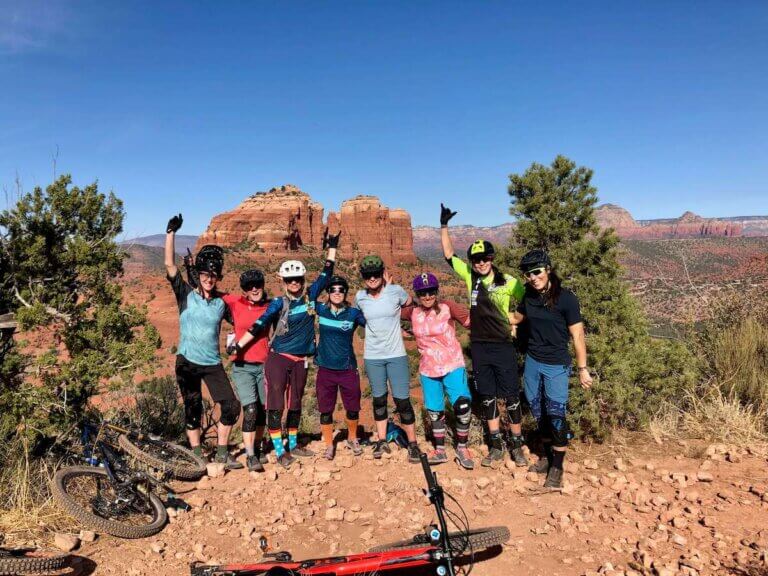
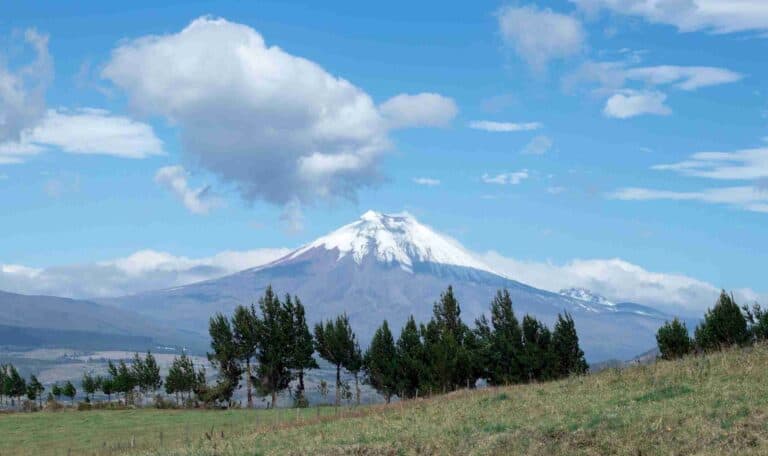
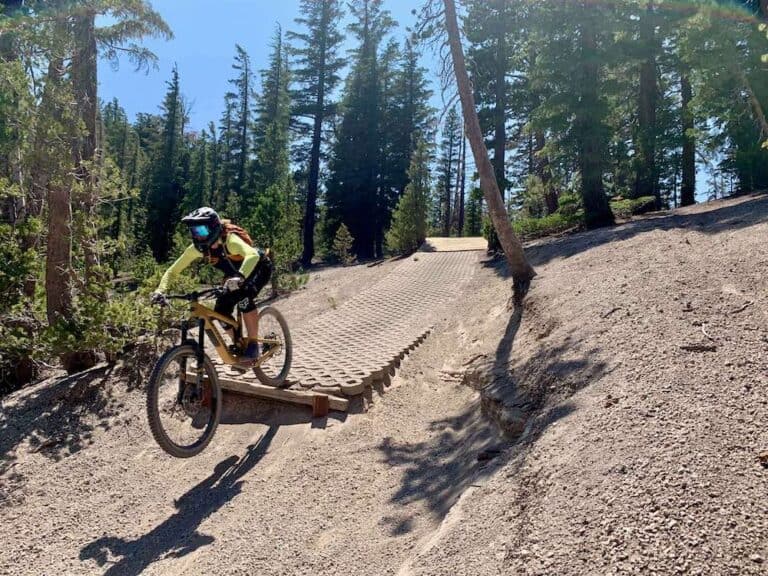
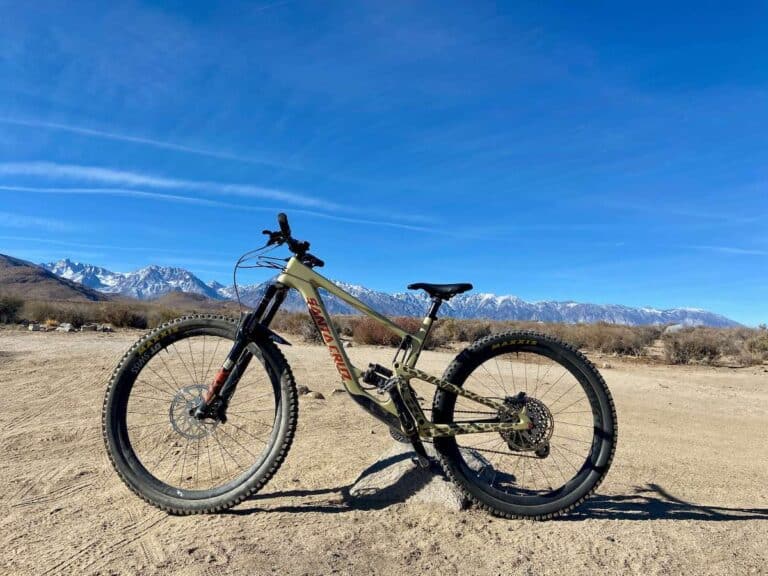
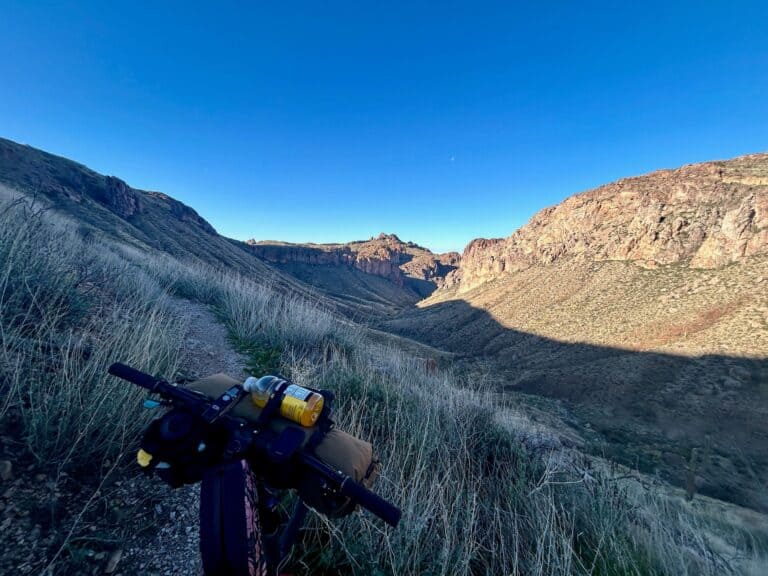
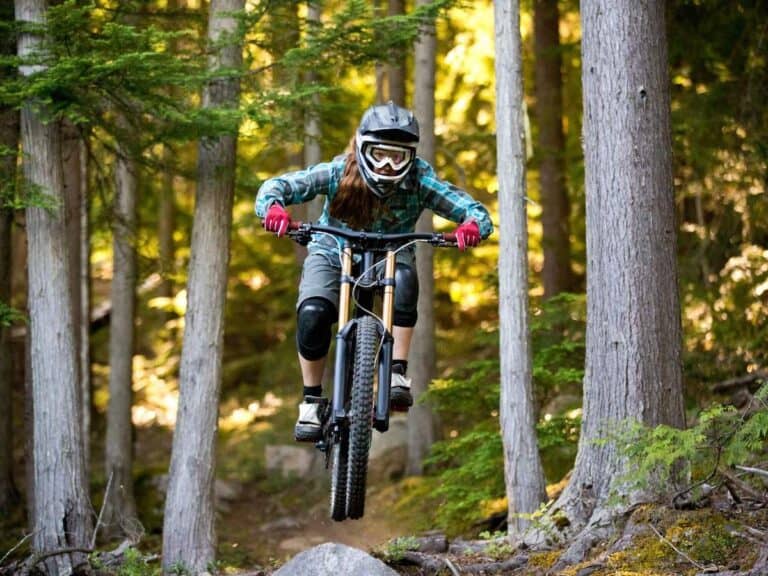
That is an excellent article, thank you! I’m a life long hiker & backpacker, but not experienced in bike packing and I picked up a LOT of good ideas in your article, AND thank you for the very nice Chamois Butt’r mention!
There are definitely similarities between backpacking and bikepacking, but also lots of differences. Glad you found this post helpful!
And I’m equally a fan of Darn Tough socks…they seem to out last Smartwool.
They’re the best!
Thanks for this list. I’m just getting back into touring on my bike. (During my tour of the Maine coast, I forgot chamois buttr and had to make an emergency stop at LL Bean cycle shop.) I’ve had a hard time finding chamois buttr in the past so I started using Bag Balm (another great Vermont product). It works great, has some medicinal uses and doubles as a lip balm. Thanks again,
Thanks for the tip! I grew up in Vermont, so I Bag Balm was a staple 🙂 Hope you had a great trip!